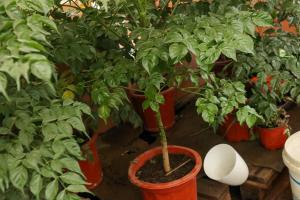Why do my tomato plant leaves have black spots?
Tomatoes are a popular and easy-to-grow plant in many home gardens. They require relatively little maintenance, but occasionally, tomato plants may develop black spots on their leaves. These spots can be a sign of several underlying issues.
Fungal Diseases
One of the most common reasons for black spots on tomato plant leaves is a fungal disease. Two common fungal diseases that can infect tomato plants are early blight and late blight. Early blight often starts as small black spots on the lower leaves of the plant and gradually spreads to other parts of the plant. Late blight, on the other hand, usually appears on the upper leaves of the plant and can spread quickly to other nearby plants.
Fungal diseases are typically caused by excessive moisture on the leaves, often due to over-watering or rainy weather. To prevent these diseases, make sure to water your tomato plants at the base of the stem and avoid getting water on the leaves. If fungal diseases do appear, it's important to remove the infected leaves immediately and dispose of them away from the garden to prevent further spread.
Bacterial Spot
Another potential cause of black spots on tomato plant leaves is a bacterial infection known as bacterial spot. This disease typically appears as dark, raised spots on the leaves and stems of the plant, often surrounded by a yellow halo. It can be spread through water, tools, and even touching infected plants.
Bacterial spot is a serious issue and can eventually kill your tomato plants. There is no cure for the disease, but you can prevent it by planting disease-resistant tomato cultivars and practicing good garden hygiene, such as disinfecting tools regularly and washing your hands before working in the garden.
Nutrient Deficiencies
Black spots on tomato plant leaves can also be a sign of nutrient deficiencies. Several essential nutrients are required for healthy tomato plant growth, including nitrogen, phosphorus, and potassium. A lack of these nutrients can result in black spots on the leaves, as well as stunted growth and poor fruit development.
To prevent nutrient deficiencies, make sure to fertilize your tomato plants regularly with a balanced fertilizer. It's also important to ensure your soil has the proper pH levels, as some nutrients may be unavailable to plants if the soil is too acidic or alkaline.
Sunscald
Finally, another potential cause of black spots on tomato plant leaves is a condition known as sunscald. This occurs when the tomatoes are exposed to too much direct sunlight, causing the leaves to become damaged and discolored. Sunscald can occur when tomato plants are not shaded properly or when they are pruned too heavily.
To prevent sunscald, try to provide some shade for your tomato plants during the hottest parts of the day. Additionally, avoid pruning your tomato plants excessively, as this can make the plants more susceptible to sun damage.
Conclusion
Black spots on tomato plant leaves can be a sign of several underlying issues, including fungal diseases, bacterial infections, nutrient deficiencies, and sunscald. By taking proper care of your tomato plants and practicing good garden hygiene, you can help prevent these issues and ensure a healthy, bountiful harvest.

 how many times do yo...
how many times do yo... how many planted tre...
how many planted tre... how many pine trees ...
how many pine trees ... how many pecan trees...
how many pecan trees... how many plants comp...
how many plants comp... how many plants can ...
how many plants can ... how many plants and ...
how many plants and ... how many pepper plan...
how many pepper plan...































